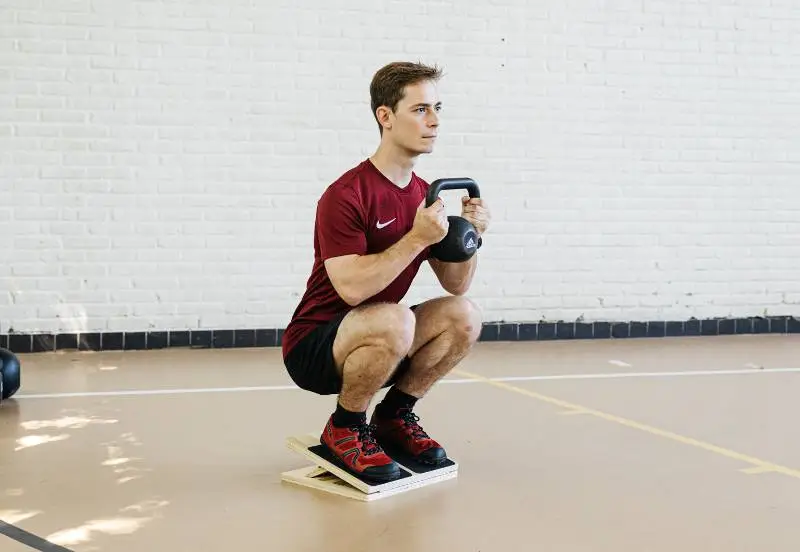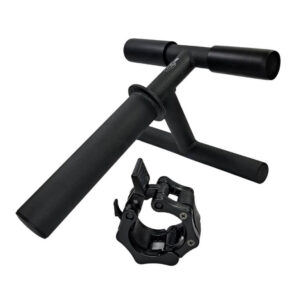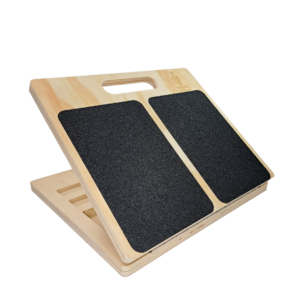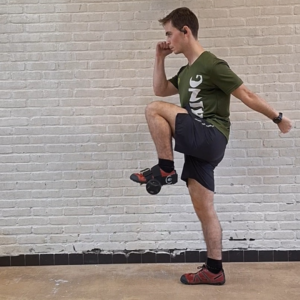
Getting into joint health is a big (much-needed) step in every athlete’s life, and ankle stability should be the first step in that journey.
As you may know, the ankle is quite a complex joint. It’s the first large joint that takes the shock from the ground, be it from running or lifting. This is why every other joint heavily depends on how ankles handle the weight.
So, let’s talk about what you can do to increase your ankle balance, and start moving your body in an optimal way!
Table of Contents
THE IMPORTANCE OF ANKLE STABILITY AND BALANCE
When you think about it, the ankles handle your whole body weight, half of it on each ankle. Now, if we factor in that this is the thinnest part of your leg, the importance of ankle stability is right there.
It is a complex joint formed by the articulation of the tibia, fibula, and talus bones. Ankle stability is maintained by ligaments, tendons, and muscles surrounding the joint and working together to absorb shock.
As the body’s shock absorbers, ankles are in charge of many things. But for athletes, the most important thing is how ankles handle the weight, dictating how the next big joint (knee) moves (e.g. joint stacking).
In terms of biomechanics, ankles are the first point in the kinetic chain and are responsible for setting the whole body for movement.
In short – we all need healthy, strong, and stable ankles, no matter the athletic discipline. Running, team sports, weightlifting, even light aerobic exercise – everyone needs to think about their ankles.
5 EXERCISES TO BUILD UP AND STRENGTHEN WEAK ANKLES
1. SINGLE-LEG STANCE
Also known as SLS, the single-leg stance is explained by its name. It is a great starting point if you’re looking to increase your ankle stability. Despite it being an absolute beginner exercise, you’d be surprised by how many athletes fail to keep the SLS for long.
Here’s how to do a single-leg stance exercise:
- Stand in a neutral stance and shift your weight to the right leg
- Standing on your right leg, raise the left leg to the side
- Keep your left leg in the air for as long as possible by stabilizing your ankle
- Switch sides and repeat with the other leg
On top of ankle stability gains, SLS also increases proprioception.
2. BOSU SINGLE-LEG STANDS
The natural next step is the bosu ball. Don’t worry, if you don’t have access to one, you can use a larger pillow at home.
The mechanics are simple:
- Stand on the bosu ball with your one leg
- Raise the other leg and do your best to keep it in the air
- Start with shorter durations, and dedicate equal time to both legs
3. SLANT BOARD GOBLET SQUATS

Now we’re getting into a more athletic territory. A slant board is a perfect tool to help you build stronger ankles without having the initial mobility to build on.
As a matter of fact, slant board goblet squats allow you to squat deeper, by setting your heel in an elevated position. In return, this positioning allows you to do a goblet squat to full ROM, allowing your ankles to get used to the load and the extended position at the same time. Additionally, squatting into a knee-over-toe position like this will also benefit the VMO (vastus medialis oblique).
Here’s how to do a slant board goblet squat:
- Set your slant board to a low angle for starters
- Stand on the slant board with your toes pointing downwards
- While holding the weight close to your chest, descend into a full ROM squat
- Push your knees out to your toes throughout the movement
- Pause at the bottom for a brief moment
- Get back up while keeping the tension in your ankles and knees
- Repeat for 8-12 reps
*Don’t be afraid to go knees over toes.
4. SINGLE-LEG ROMANIAN DEADLIFTS
In contrast to its bipedal counterpart, the single-leg Romanian deadlift develops ankle stability as well. The movement requires you to balance the body through a single ankle while hinging at the hips. Not to mention the glute and hamstring gains!
Here’s how to do single-leg Romanian deadlifts:
- Stand on one leg while holding a kettlebell with both hands in front of you
- Lock in your shoulders, straighten your back, and brace your core
- With a slightly bent knee, slowly hinge at your hips
- Let the weight go down, and keep the tension from your ankles to your core
- Once you reach your mobility limit, get up by squeezing your glutes, while pushing your hips forward
- Repeat for 8-12 reps and switch legs
5. SLANT BOARD CALF RAISES
Lastly, we have an exercise that works on your ankle stability, yes, but it also develops the calves like crazy.
Compared to the standard calf raise, the slant board version allows you to start from the point of dorsiflexion. In return, this enables you to do calf raises with a significantly larger ROM.
Here’s how to do slant board calf raises:
- Set a low angle on your slant board for starters
- Stand on the slant board with your feet in the elevated position (opposite of the goblet squat)
- Through the balls of your feet, push yourself up.
- Squeeze and hold in the top position for a brief moment and go back down.
- Repeat for 8-12 reps
If you want to increase the difficulty, you can start with a higher angle on the slant board. Take your time to master each version.
EXERCISING FOR ANKLE STABILITY – FAQ
1. HOW OFTEN SHOULD I DO ANKLE STABILITY EXERCISES?
Since ankles are used almost all the time, ankle recovery is not that big of an issue. You can train your ankles 2 to 3 times a week.
Just remember to keep your ankle training program versatile.
2. WHY ARE ANKLE EXERCISES IMPORTANT?
Ankles are first on the line when it comes to shock absorption from the ground. If ankles fail to do their job properly, every joint above it will fail as well.
That’s why athletes need to focus on ankle exercises more – ankle stability dictates virtually every athletic movement out there.
3. WHAT ARE THE BENEFITS OF ANKLE EXERCISES?
If you start training your ankles, you can expect improvements in every compound movement you do. If you’re a runner, ankle exercises will help you recover faster. Additionally, developed ankles can help prevent a whole lot of problems with the spine.
4. IS KNEES-OVER-TOES TRAINING GOOD FOR YOUR ANKLES?
It’s not good – it’s great. The knees-over-toes (aka KOT) approach to exercising prioritizes healthy movement in every natural direction. We, as humans, are built to squat deep, and the only way to achieve that in a healthy way is to go knees over toes.
So, yes, if done correctly, the KOT approach can help you with ankle stability quite a lot!
IN CONCLUSION
Ankle stability exercises can be cumbersome. There’s no glorious aesthetics in doing most of these exercises, and most people just skip the.
But, the actual payoff is beyond just healthy ankles. Your running and lifting performance will vastly improve, as well as your coordination and proprioception. It is a win-win after all.
SO, START YOUR ANKLE-BUILDING JOURNEY TODAY!
GET THE BEST INJURY-PREVENTION TRAINING EQUIPMENT:
Above all, a storyteller. Then comes marketing, branding, writing music, powerlifting, and woodworking.







